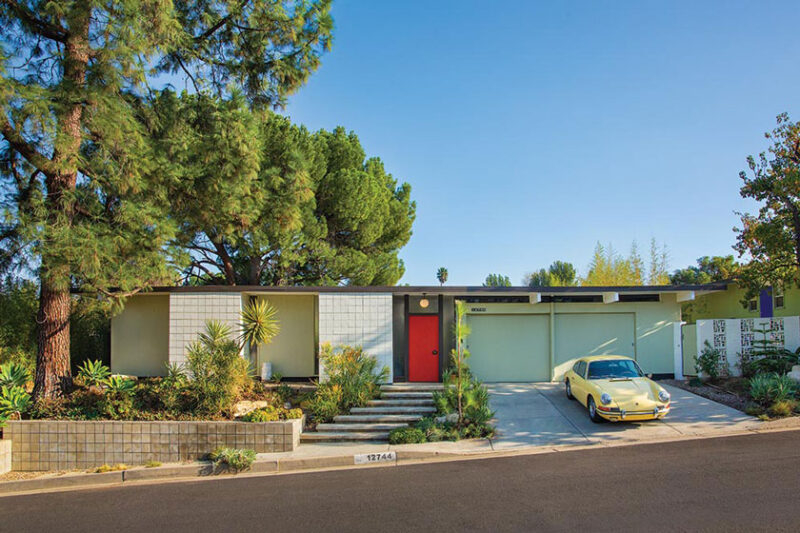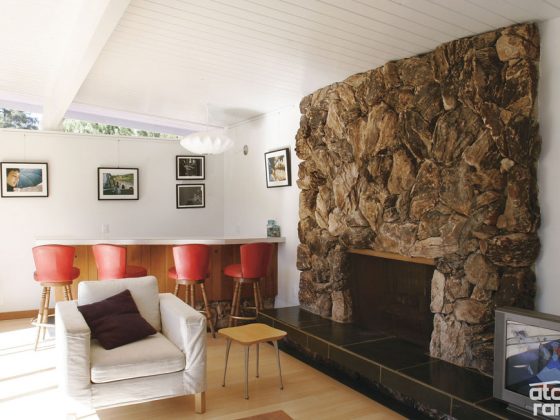An Eichler home owner decorates his home in harmony with nature, design, music and art.
A visit to Charles Danek’s mid-century home is a delight, not only for the eyes, but for the ears as well. Music has always been an important part of Charles’s life, and he knew that displaying musical instruments in his home would be an essential element in its décor. The instruments add a distinctive quality, turning the house into a home.
“My daughter, Iris, and I are both musicians, so these musical instruments displayed throughout our house get played often,” Charles explains. “I like what they contribute to the ambiance of our home. A celebration of natural materials is a defining trait of Mid Century Modern design, but the same trait also describes musical instruments throughout time.”

Charles came to Los Angeles in the mid-1990s with aspirations of becoming a singer-songwriter. His professional experience in photography production with the likes of rock-music photographer Christopher Wray-McCann morphed into his current role: location scout.
“As a location scout, I get to explore many of the most fantastic houses in Los Angeles. I think this perspective is what first spurred me to recognize how a house could go beyond being a functional domicile to become a vehicle for creative expression. Through scouting, I’ve gained a firsthand education in architecture and interior design.”

Charles was not planning to move at the time this Eichler home presented itself, but the couple he had bought his first home from informed him they were moving from their home in the Balboa Highlands Eichler tract of Granada Hills, California.

“Our house was designed by Claude Oakland for Joseph Eichler and was built in 1964. It’s an example of post-and-beam California Modernism, and it has many defining Eichler attributes, including a flat roofline, floor-to-ceiling glass, mahogany paneling, an open kitchen/family room (currently used as an informal dining area) and, most quintessentially, an atrium courtyard in the center of the house.”
It was originally designed with five bedrooms, but it’s currently configured as a three-bedroom-plus-office with a double-room master suite, Charles explains.
“Joseph Eichler’s whole concept was to use enlightened architecture and creatively planned streets to create ‘utopia’ in the suburbs, and that’s essentially what we found in the Balboa Highlands Eichler tract of Granada Hills,” Charles says.



“It was a real revelation to discover how these unique houses had attracted a community of unique enthusiasts. In our neighborhood, we have artists, musicians, actors, producers, architects, animators, editors and ‘imagineers’ who are all drawn together by our shared passion for these special houses.”
Luckily, when Charles moved in, the Eichler home had already been meticulously restored to its architectural roots.


“The credit for our home’s remodeling is owed to its previous owners; they had the vision to buy a heavily altered Eichler and chose restoration over renovation,” Charles notes. “As when returning a classic car to its factory-original condition, they researched correct replacement materials and fixtures and recreated the house as correctly as possible. For the 13 years we’ve been stewards of this house, it’s been our goal to not give up any ground the previous owners fought to gain back toward keeping our house as original as possible. A constant has been that the most ‘social’ room in the house, just as Joseph Eichler astutely understood, has always been—and will likely always be—the kitchen.”
Balancing Act
The home’s décor strikes a balance between mid-century and personal treasured pieces.
“I would describe my approach to interior design as balancing mid-century icons that make a bold first impression with family history furnishings and personal artwork that lend unique character and warmth … along with a smattering of Ikea to help glue things together as necessitated by function and budget,” Charles says. “I was always captivated by antiques, and I curated old objects I found in our basement. These objects are now on display in every room of my house. Some of them, such as my blender and record player, are still doing the job they were built for more than 50 years ago. An especially satisfying aspect of Eichler ownership is providing a natural setting for all these pieces of family history I’ve saved and being able to engage them in my daily life.”
This Eichler Home’s Color Story
Charles found that the home’s existing paint colors suited his taste as well.
“Eichler houses typically have muted exteriors that are contrasted with a bright front door. We loved the colors the previous owners chose so much that we kept them,” Charles points out. “In the kitchen/family room, they went with yellow linoleum tiles similar to what was there originally. However, for the rest of the house, they went with parquet wood—except in the living room, where they used travertine. Although these are not original Eichler options, they are at least period-appropriate.”

Color also played a pivotal role in Charles’s decorating choices.
“When it came to furnishing the house, colors were sometimes dictated by what I happened to find,” he explains. “For example, the four Burke shell chairs in our dining set all happened to be different colors when I found it on Craigslist. In other instances, I was able to just sort of listen to what the house was asking for. My master bedroom told me it wanted ochres and earth tones. The large painting in the formal living room wanted dark grays and black-purples to contrast with the sunlight that streams across it every day.”




If you love this Eichler home, don’t miss our articles on Joseph Eichler, as well as other Eichler homes such as An Enigmatic Eichler, Rebuilding an Eichler, and Eichler Orange: Designer Lin He Updates an Eichler in Orange, California. And of course, don’t forget to follow us on Instagram, Facebook and Pinterest for more Mid Century Modern inspiration!












